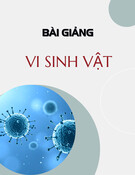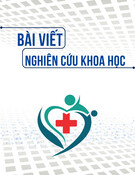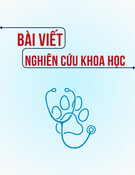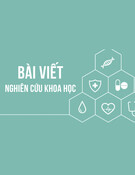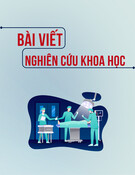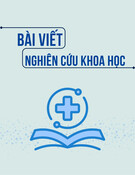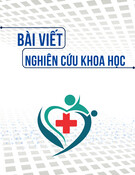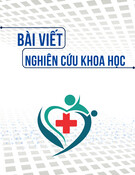
www.tapchiyhcd.vn
62
► CHUYÊN ĐỀ LAO ◄
INSTITUTE OF COMMUNITY HEALTH
INVESTIGATING THE STATUS OF HOSPITAL-ACQUIRED PNEUMONIA AND
ANTIBIOTIC USAGE IN THE TREATMENT OF HOSPITAL-ACQUIRED
PNEUMONIA AT THONG NHAT HOSPITAL
Le Van Lam*, Vo Thi Hoa, Nguyen Thi Ngoc Thuy, Ha Le Viet Dung,
Ho Quoc Cuong, Tran Thi Phuong Mai, Bui Thi Huong Quynh, Pham Thi Thu Hien
Thong Nhat Hospital - 1 Ly Thuong Kiet, Ward 14, Tan Binh Dist, Ho Chi Minh City, Vietnam
Received: 16/08/2024
Revised: 30/08/2024; Accepted: 09/10/2024
ABSTRACT
Objective: The study aimed to assess the prevalence of Hospital-acquired pneumonia (HAP)
and analyze the antibiotic usage in treating HAP at Thong Nhat Hospital.
Subjects and Methods: A cross-sectional study was conducted, retrieving data from the
medical records of inpatients treated at Thong Nhat Hospital in August 2023. Screening of
medical records met the diagnostic criteria for HAP, including patients diagnosed with HAP
by physicians or those diagnosed with pneumonia after at least 48 hours of hospitalization
(satisfying the diagnostic criteria outlined in the 2016 Infectious Diseases Society of
America/American Thoracic Society (IDSA/ATS) guidelines on the management of HAP
and ventilator-associated pneumonia). A comparison of various indices, including treatment
duration, medication costs, and antibiotic usage costs, was conducted between patient groups
with and without HAP. Microbial analysis, antibiotic usage, and defined daily doses (DDD)/100
days of treatment were examined in patients with HAP.
Results: The results from 2855 medical records revealed that there were 208 cases of HAP,
accounting for 7.29%. The average age of patients with HAP was 72.65 years, with a male
gender ratio of 55.77%. Patients with HAP had an extended treatment duration of
approximately 7.35 days, resulting in a 2.7 times increase in treatment costs, a 10 times
increase in medication costs, and a 25 times increase in antibiotic costs compared to patients
without HAP. The mortality/severity rate in the healthcare-associated infection group was
significantly higher compared to without HAP (22 times). The primary causative agents of HAP
were Gram-negative bacteria, constituting 71.25%, including Klebsiella pneumonia (22.82%),
Escherichia coli (16.78%), Pseudomonas aeruginosa (11.41%), and Acinetobacter baumannii
(9.4%). Gram-positive bacteria accounted for 18.79%, with Staphylococcus being the highest at
16.78%. Fungi were also identified as causative agents, with a prevalence of 10.06%. The main
antibiotics used for treatment were antibiotics group I, representing 50.33% of the total DDD
per 100 days of treatment and constituting 80.88% of the antibiotic treatment costs.
Conclusion: HAP is one of the common hospital-acquired infections. Patients with HAP often
experience prolonged hospital stays, leading to increased treatment costs, decreased treatment
effectiveness, and reduced quality of healthcare.
Keywords: Hospital-acquired pneumonia (VPBV), antibiotics.
*Corresponding author
Email: levanlam20101987@gmail.com Phone: (+84) 961632552 Https://doi.org/10.52163/yhc.v65iCD10.1596
Vietnam Journal of Community Medicine, Vol. 65, Special Issue 10, 62-70

63
KHẢO SÁT THỰC TRẠNG VIÊM PHỔI BỆNH VIỆN VÀ SỬ DỤNG KHÁNG SINH
TRONG ĐIỀU TRỊ VIÊM PHỔI BỆNH VIỆN TẠI BỆNH VIỆN THỐNG NHẤT
Lê Văn Lâm*, Võ Thị Hoa, Nguyễn Thị Ngọc Thùy, Hà Lê Việt Dũng,
Hồ Quốc Cường, Trần Thị Phương Mai, Bùi Thị Hương Quỳnh, Phạm Thị Thu Hiền
Bệnh viện Thống Nhất - Số 1 Lý Thường Kiệt, P. 14, Q. Tân Bình, Tp. Hồ Chí Minh, Việt Nam
Ngày nhận bài: 16/08/2024
Chỉnh sửa ngày: 30/08/2024; Ngày duyệt đăng: 09/10/2024
TÓM TẮT
Mục tiêu: Khảo sát thực trạng viêm phổi bệnh viện và phân tích tình hình sử dụng kháng sinh
trong điều trị VPBV tại Bệnh viện Thống Nhất.
Đối tượng nghiên cứu và phương pháp: Nghiên cứu mô tả cắt ngang, hồi cứu từ hồ sơ bệnh án
của bệnh nhân điều trị nội trú tại Bệnh viện Thống Nhất từ 01/08/2023 đến 31/08/2023. Sàng lọc
hồ sơ bệnh án có đủ tiêu chuẩn chẩn đoán VPBV, là những bệnh nhân được bác sĩ ghi chẩn đoán
VPBV hoặc chẩn đoán viêm phổi sau ít nhất 48 giờ nhập viện (thoả mãn tiêu chuẩn chẩn đoán
theo hướng dẫn của Hiệp hội Bệnh Truyền nhiễm Hoa Kỳ/Hiệp hội Lồng ngực Hoa Kỳ (IDSA/
ATS) năm 2016 về quản lý VPBV và viêm phổi thở máy). So sánh các chỉ số về thời gian điều
trị, chi phí sử dụng thuốc, chi phí sử dụng kháng sinh giữa nhóm bệnh nhân có hoặc không có
VPBV. Tiến hành phân tích vấn đề vi sinh, sử dụng kháng sinh và liều dùng một ngày/100 ngày
điều trị của những bệnh nhân có VPBV.
Kết quả: Kết quả đánh giá 2855 hồ sơ bệnh án ghi nhận có 208 trường hợp VPBV chiếm
7,29%. Đối tượng VPBV có độ tuổi trung bình cao 72,65 tuổi, tỷ lệ giới tính nam là 55,77%.
Bệnh nhân mắc VPBV có thời gian điều trị kéo dài thêm khoảng 7,35 ngày, tăng chi phí điều
trị thêm gấp 2,7 lần, chi phí thuốc tăng gấp 10 lần và chi phí kháng sinh tăng gấp 25 lần so với
bệnh nhân không mắc VPBV. Tỷ lệ tử vong/bệnh nặng xin về ở nhóm VPBV cao gấp 22 so
với bệnh nhân không mắc VPBV. Tác nhân gây bệnh chủ yếu của VPBV là vi khuần Gram (-)
chiếm 71,25%, trong đó Klebsiella pneumonia 22,82%, Escherichia coli 16,78%, Pseudomonas
aeruginosa 11,41%, Acinetobacteria baumannii 9,4%. Vi khuẩn gram (+) chiếm tỷ lệ 18,79%
trong đó họ Staphylococcus chiếm tỷ lệ cao nhất 16,78%. Nấm cũng là tác nhân gây bệnh được
ghi nhận với tỷ lệ 10,06%. Kháng sinh điều trị chủ yếu là kháng sinh ưu tiên quản lý nhóm 1
với tỷ lệ 50,33% tổng liều dùng một ngày/100 ngày điều trị và chiếm 80,88% chi phí kháng
sinh điều trị.
Kết luận: VPBV là một trong những nhiễm khuẩn bệnh viện thường gặp, bệnh nhân mắc VPBV
có thời gian nằm viện kéo dài làm tăng chi phí điều trị, giảm hiệu quả điều trị và chăm sóc y tế.
Từ khóa: Viêm phổi bệnh viện (VPBV), kháng sinh.
1. ĐẶT VẤN ĐỀ
Viêm phổi là tình trạng nhiễm khuẩn của nhu mô phổi
bao gồm viêm phế nang, ống và túi phế nang, tiểu phế
quản tận hoặc viêm tổ chức kẽ của phổi. Tác nhân gây
viêm phổi có thể là các vi khuẩn, virus, ký sinh trùng,
nấm, hoặc hóa chất. Trong đó viêm phổi bệnh viện
(Hospital-acquired pneumonia - HAP) chủ yếu do
vi khuẩn gram âm là các tác nhân gây bệnh thường
gặp nhất, cụ thể như: Pseudomonas aeruginosa,
Klebsiella spp., Escherichia coli và Acinetobacter
baumannii. Ngoài ra Staphylococcus aureus kháng
Methicillin (MRSA) cũng là tác nhân gây VPBV phổ
biến. VPBV thường gặp ở các đối tượng bệnh nhân suy
giảm miễn dịch [4, 10]. VPBV là nhiễm khuẩn thường
gặp trong các nhiễm khuẩn liên quan đến chăm sóc y tế
(Healthcare – associated infections, HAIs), viêm phổi
chiếm khoảng 21,4% các trường hợp được báo cáo
HAIs [5].
Tỷ lệ mắc VPBV tăng lên theo từng nhóm đối tượng
bệnh nhân. Theo một số nghiên cứu cho thấy rằng tỷ lệ
L.V. Lam et al. / Vietnam Journal of Community Medicine, Vol. 65, Special Issue 10, 62-70
*Tác giả liên hệ
Email: levanlam20101987@gmail.com Điện thoại: (+84) 961632552 Https://doi.org/10.52163/yhc.v65iCD10.1596

www.tapchiyhcd.vn
64
mắc viêm phổi và tỷ lệ tử vong do viêm phổi tăng lên ở
đối tượng bệnh nhân lớn tuổi (tỷ lệ viêm phổi ở người
trên 65 tuổi chiếm 50% số ca mắc, tỷ lệ tử vong do viêm
phổi chiếm 90% số ca tử vong) [6, 9].
Bệnh viện Thống Nhất là bệnh viện lão khoa lớn nhất
khu vực phía nam và cả nước, đối tượng bệnh nhân đa
số là người cao tuổi, đa bệnh lý, là nhóm đối tượng có
nguy cơ cao, vì vậy cần phải được đánh giá và quan tâm
đúng mức khi điều trị nhóm đối tượng bệnh nhân này
tại bệnh viện. Chính vì vậy chúng tôi tiến hành nghiên
cứu “Khảo sát thực trạng viêm phổi và sử dụng kháng
sinh trong điều trị viêm phổi bệnh viện ở người cao tuổi
tại Bệnh viện Thống Nhất năm 2023’’ với hai mục tiêu:
1. Khảo sát đặc điểm đối tượng nghiên cứu và thực
trạng viêm phổi bệnh viện tại Bệnh viện Thống Nhất
2. Phân tích tác nhân gây bệnh và tình hình sử dụng
kháng sinh trong điều trị viêm phổi bệnh viện tại Bệnh
viện Thống Nhất.
2. ĐỐI TƯỢNG VÀ PHƯƠNG PHÁP NGHIÊN CỨU
2.1. Thiết kế nghiên cứu: Nghiên cứu mô tả cắt ngang,
hồi cứu từ hồ sơ bệnh án của bệnh nhân xuất viện tại
Bệnh viện Thống Nhất nhằm khảo đặc điểm đối tượng
bệnh nhân, tỷ lệ mắc VPBV, nhóm tác nhân gây bệnh,
đặc điểm kháng sinh điều trị cho đối tượng bệnh nhân
mắc VPBV.
2.2. Địa điểm và thời gian nghiên cứu: Nghiên cứu
được thực hiện tại Bệnh viện Thống Nhất. Thời gian
thực hiện nghiên cứu từ 01/08/2023 đến 31/08/2023.
2.3. Đối tượng nghiên cứu: Thu thập hồ sơ bệnh án
của bệnh nhân xuất viện trong thời gian từ 01/08/2023
đến 31/08/2023.
2.4. Cỡ mẫu, chọn mẫu: Cỡ mẫu được xác định là
tất cả các hồ sơ bệnh án của bệnh nhân xuất viện từ
01/08/2023 đến 31/08/2023.
2.5. Biến số/chỉ số/nội dung/chủ đề nghiên cứu
- Khảo sát được đặc điểm của đối tượng nghiên cứu:
+ Giới tính.
+ Tuổi chia thành các nhóm cách nhau 20 năm.
+ Đặc điểm bệnh nền là tình trạng y khoa nền
(underlying medical condition), có thể được hiểu là
những vấn đề về sức khỏe đã có sẵn hoặc bệnh kèm
theo là những bệnh cùng tồn tại với bệnh chính tại thời
điểm nhập viện hay bệnh tiến triển hoặc phát hiện trong
quá trình điều trị bệnh chính, có ảnh hưởng đến việc
chăm sóc và điều trị cho người bệnh, dẫn đến việc kéo
dài thời gian nằm viện hoặc phải sử dụng các nguồn lực
bổ sung khác.
+ Số ngày nằm viện.
+ Chi phí điều trị.
- Khảo sát được tỷ lệ VPBV trên nhóm đối tượng nghiên
cứu dựa trên các tiêu chuẩn chẩn đoán như sau [10]:
Tiêu chuẩn lâm sàng
Có tổn thương mới hoặc thâm nhiễm tiến triển trên
phim X-quang phổi xuất hiện sau 48 giờ nằm viện
Kèm thêm ít nhất 2 trong số các
biểu hiện sau:
Sốt
Khạc đờm mủ
Bạch cầu máu ngoại vi tăng > 10
giga/l hoặc giảm < 3,5 giga/l
Độ bão hòa oxy trong máu giảm
Tiêu chuẩn
chẩn đoán vi sinh định lượng
dịch tiết đường hô hấp dưới
Đờm: > 1 x 105 CFU/ml (Colomy Forming Unit: Đơn vị khuẩn lạc)
Chất tiết khí quản: > 1 x 106 CFU/ml
Chải có bảo vệ: > 1 x 103 CFU/ml
Dịch rửa phế quản phế nang: > 1 x 104 CFU/ml
Hoặc phân lập vi khuẩn từ cấy máu hay dịch màng phổi
- Khảo sát được nhóm tác nhân gây bệnh thường gặp.
- Phân tích tình hình sử dụng kháng sinh trên đối tượng
bệnh nhân viêm phổi bệnh viện.
+ Đặc điểm nhóm kháng sinh điều trị, loại kháng sinh
điều tri.
+ Chi phí kháng sinh điều trị.
+ Mức tiêu thụ kháng sinh tính theo liều dùng một ngày
(DDD - Defined Daily Dose) là liều trung bình duy trì
hàng ngày với chỉ định chính của một thuốc. Báo cáo
dưới dạng DDD/100 hoặc 1000 (người - ngày hoặc
ngày – giường).
L.V. Lam et al. / Vietnam Journal of Community Medicine, Vol. 65, Special Issue 10, 62-70

65
2.6. Phương pháp xử lý số liệu: Tất cả dữ liệu được
tổng hợp, xử lý và phân tích bằng phần mềm Microsoft
Excel. Các phép kiểm định thống kê được thực hiện với
phần mềm SPSS 2.0.
2.7. Đạo đức nghiên cứu: Nghiên cứu được sự đồng ý
và chấp thuận của Hội đồng đạo đực Bệnh viện Thống
Nhất. Các thông tin liên quan đến bệnh nhân được thu
thập từ hồ sơ bệnh án chỉ nhằm phục vụ cho nghiên cứu.
3. KẾT QUẢ NGHIÊN CỨU
3.1. Đặc điểm mẫu nghiên cứu
Nghiên cứu thực hiện đánh giá các hồ sơ bệnh án
của bệnh nhân ra viện tại Bệnh viện Thống Nhất từ
01/08/2023 đến 31/08/2023. Thống kê và loại bỏ những
bệnh án không đạt tiêu chí trong nghiên cứu. Chúng tôi
thống kê được 2855 bệnh án đáp ứng yêu cầu để phân
tích. Số bệnh án có chẩn đoán VPBV và đáp ứng được
các tiêu chí của chẩn đoán VPBV là 208 bệnh án (chiếm
khoảng 7,29%). Đặc điểm của đối tượng bệnh nhân chi
tiết bảng dưới đây.
Bảng 1. Đặc điểm đối tượng bệnh nhân
Đặc điểm bệnh nhân Bệnh nhân VPBV (n=208) Bệnh nhân không VPBV
(n=2647)
Số lượng Tỷ lệ (%) Số lượng Tỷ lệ (%)
Tuổi
10- 30 3 1,44 206 7,78
31- 50 16 7,69 527 19,91
51 - 70 72 34,62 1.057 39,93
> 70 117 56,25 857 32,38
Giới tính Nam 116 55,77 1.341 50,66
Nữ 92 44,23 1.367 49,34
Bệnh nền của
bệnh nhân
1 bệnh nền 41 19,71 800 30,22
2 bệnh nền 45 21,63 555 20,97
3 bệnh nền 48 23,08 405 15,30
Nhiều hơn 3
bệnh nền 135 64,90 948 35,81
Tăng huyết áp 104 50,00 1.507 56,93
Đái tháo đường
tuýp 2 199 95,67 735 27,77
Rối loạn
Lipoprotein 130 62,50 1.259 47,56
Bệnh đường tiêu
hóa 172 82,69 1.457 55,04
Tim mạch khác
(suy tim, bệnh
mạch vành…) 139 66,83 1.020 38,53
Suy thận 87 41,83 396 14,96
Bệnh khác
(bệnh cơ xương
khớp, bệnh thần
kinh…)
25 12,02 695 26,26
Nhận xét: Nhóm bệnh nhân VPBV có độ tuổi > 70 chiến tỷ lệ cao trên 50%, nhóm bệnh nhân không mắc viêm
phổi bệnh viện tỷ lệ phân bố độ tuổi tương đối đồng đều, trong đó nhóm tuổi có tỷ lệ thấp nhất là từ 10 – 30 tuổi
và cao nhất là nhóm tuổi 50 - 70 tuổi. Nam giới có tỷ lệ mắc VPBV cao hơn nữ (Nam chiếm 55,77%), nhóm đối
tượng không mắc VPBV tỷ lệ phân bố nam nữ là như nhau (Nam 50,66%, nữ 49,34%). Về đặc điểm bệnh nền cho
L.V. Lam et al. / Vietnam Journal of Community Medicine, Vol. 65, Special Issue 10, 62-70

www.tapchiyhcd.vn
66
thấy bệnh nhân VPBV có nhiều hơn 3 bệnh nền chiếm tỷ lệ cao (64,90%), nhóm đối tượng không mắc VPBV có
nhiều hơn 3 bệnh nền cũng là nhóm có tỷ lệ cao nhất (35,81%) nhưng thấp hơn nhiều so với đối tượng bệnh nhân
VPBV. Bệnh nền chủ yếu của hai nhóm nghiên cứu thường gặp như: Tăng huyết áp, đái tháo đường tuýp 2, bệnh
tiêu hóa, tim mạch. Đặc biệt bệnh nền đái tháo đường tuýp 2 ở bệnh nhân VPBV chiếm tỷ cao (95,67%).
Đặc điểm điều trị nhóm đối tượng bệnh nhân VPBV so với nhóm bệnh nhân không mắc VPBV. Kết quả được trình
bày tại bảng dưới đây:
Bảng 2. Đặc điểm điều trị của bệnh nhân mắc VPBV và bệnh nhân không VPBV
Đặc điểm điều trị Bệnh nhân mắc
VPBV (n=208)
Bệnh nhân
không VPBV
(n=2647) P-value (0,05)
Tuổi trung bình 72,65 (±15,19) 60,56 (±18,32) <0.001
Số ngày nằm viện trung bình 16,13 (±8,07) 8,78 (±5,33) <0.001
Tỷ lệ tử vong/bệnh nặng xin về 12,98 %(n=27) 0.57%(n=15) <0.001
Chi phí điều trị trung bình 47.869.741,80
(±70.464.968,8)
17.928.437,06
(±46.166.278,7) <0.001
Chi phí thuốc 23.243.577,25
(±28.382.236,07)
2.293.432,72
(±4.819.887,8) <0.001
Chi phí kháng sinh 17.869.873,90
(±34.800.450.9)
676.085,60
(±2.919.967,7) <0.001
Nhận xét: Độ tuổi trung bình bệnh nhân VPBV là 72,65 tuổi, cao hơn so với độ tuổi trung bình của bệnh nhân
không VPBV (60,56%). Các đặc điểm về số ngày điều trị, chi phí điều trị, chi phí thuốc, chi phí kháng sinh đều
cho thấy nhóm bệnh nhân mắc VPBV cần thời gian và chi phí điều trị lớn hơn so với bệnh nhân không VPBV. Sự
khác biệt này đều có ý nghĩa thống kê (p<0,001).
3.2. Đặc điểm tác nhân gây bệnh VPBV
Trong 208 bệnh nhân VPBV có 149 bệnh nhân được thực hiện xét nghiệm vi sinh chiếm 71,63%. Các vi
khuẩn gây bệnh phân lập được chủ yếu là gram (-) như: Klebsiella pneumonia, Escherichia coli, Pseudomonas
aeruginosa, Acinetobacteria baumannii… ngoài ra còn có nấm và vi khuẩn gram (+) dương cũng được ghi nhận:
Kết quả vi sinh được tổng hợp tại bảng dưới đây.
Bảng 3. Nhóm tác nhân gây VPBV
Đặc điểm Cở mẫu (n=208) Tỷ lệ (%)
Tỷ lệ xét nghiệm vi sinh 149 71,63
Vi khuẩn phân lập
Vi khuẩn gram (-) 106 71,25
Klebsiella pneumoniae 34 22,82
Escherichia coli 25 16,78
Pseudomonas aeruginosa 17 11,41
Acinetobacteria baumannii 14 9,40
Enterobacter aerogenes (-) 8 5,37
Vi khuẩn gram (-) khác 8 5,37
Vi khuẩn gram (+) 28 18,79
L.V. Lam et al. / Vietnam Journal of Community Medicine, Vol. 65, Special Issue 10, 62-70



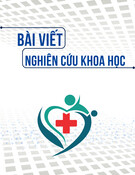





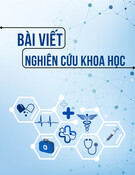


![Bài giảng Vi sinh vật: Đại cương về miễn dịch và ứng dụng [chuẩn nhất]](https://cdn.tailieu.vn/images/document/thumbnail/2025/20251124/royalnguyen223@gmail.com/135x160/49791764038504.jpg)
